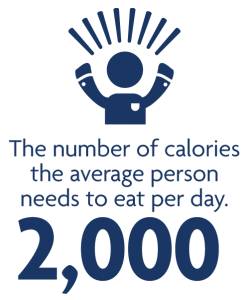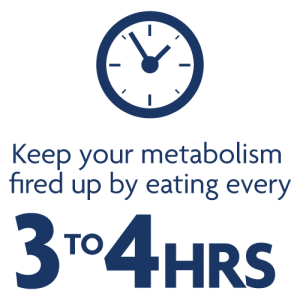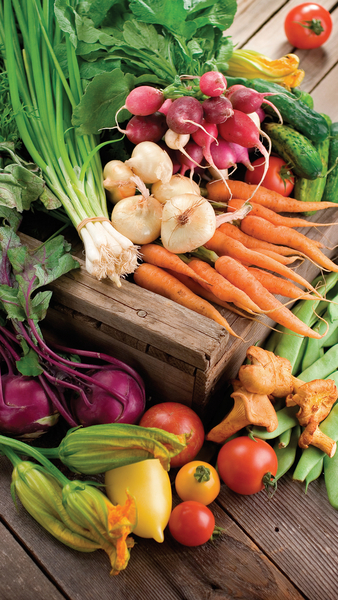Calories Can Count
A Healthy You
JUMP TO: Home | Calories Can Count | Nutrients Are Key | Portion Size Matters | A Plan Is Paramount
Calories Can Count
 Achieve Energy Balance
Achieve Energy Balance
Maintaining a healthy weight is key to long-term health, and it’s all about balance. By consuming the same number of calories that you burn through your baseline metabolic rate, activities of daily living and exercise, you can achieve “energy balance” and prevent weight gain.
- To lose weight you must burn more calories than you consume by moving more, eating less, or a combination of both.
- To gain weight you must consume more calories than you burn by either eating more, moving less, or a combination of both.
Learn the Calorie Landscape
Calorie information is all around you — on packaged foods in your kitchen, on company websites, on many restaurants signs, and on everyday favorite menu items at cafebonappetit.com. By learning how to navigate the calorie landscape, you can start to recognize which foods and meals contribute the most calories to your daily intake, and develop a plan to stay within your calorie budget.
- Read labels: All packaged foods include calorie and other nutrient information. You can also find calorie information on our everyday favorite menu items in the café.
- Track it in an app: Tracking your calories and activity on a website or app such as LoseIt or MyFitnessPal can help shed light on how many calories you are actually eating per day, overall energy balance, and highlight where you may be able to adjust.
Fire Up Your Metabolism

Your body needs fuel throughout the day to keep it running. Eating regularly keeps you energized and your metabolism working at its best.
- Plan ahead: Most people get hungry every three to four hours. Plan regular meals along with healthy snacks to feel great all day, and ward off overeating at your next meal.
- Stay satiated: Long stretches between meals can lead to poor food decisions. Think about it — when you are starving, do you reach for the vegetables or the candy bowl? Keep a healthy snack on hand to ward off temptation.
- Tick tock: You don’t have to be pressured by the clock. As long as your meals and snacks fit within your total calorie budget, it doesn’t matter what time you eat them. Early risers may need a mid-morning snack or small second breakfast. Night owls might feel hungry a few hours after dinner, and need a little boost to keep that midnight oil burning.
- Snack smart: Eat a mix of lean protein and fiber (from fruits, vegetables, nuts, seeds, or whole grains). It will keep your brain engaged and your energy level stable.
Think Beyond the Numbers

If you’re eating at a friend’s house or in a restaurant, the calories for a specific food might may not be available. If that’s the case, don’t fret! Use the following tactics to make smart calorie decisions, because it’s about the foods you choose, not just the numbers:
- Watch the starch: Choose non-starchy vegetables (broccoli, zucchini, leafy greens, cucumbers, beets, eggplant, mushrooms, etc.) over their starchy cousins (potatoes, corn, peas, and butternut and other winter squashes) which have more calories.
- Go lean with protein: Look for tofu (and other soy products), beans, and fish, which are the leanest proteins, followed by skinless poultry. When choosing red meat, choose leaner (lower calorie) cuts such as top round and sirloin instead of porterhouse, strip steak, or rib-eye. At the grocery store, look for lean (3-5% fat) ground beef or turkey.
- Pick whole grains more often: While whole and refined grains offer similar calories, whole grains provide the benefit of fiber, which can help you keep portions in control, and contribute other beneficial nutrients. For most, choosing smaller portions of grains helps achieve energy balance.
- Focus on fresh flavors: Creamy and cheesy sauces are mighty comforting, but they add a lot of calories. Instead, look for dishes made with fresher flavors like citrus, herbs, and spices.
- Mind the (cooking) method: Choose items that are grilled, baked, or roasted instead of items that are stir-fried or deep fried.
Once you know more about your calorie needs, you’ll feel comfortable navigating almost any food environment whether calorie information is available or not. Just use what you know about foods and food preparation to make the best choices. More importantly, listen to your hunger level, so you don’t get too hungry and make poor decisions.
The caloric landscape isn’t just about the numbers though, it’s about nutrients and the quality of those calories, too. Learn more about nutrients here.